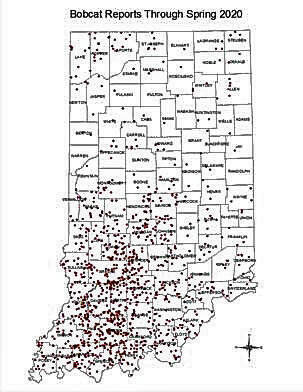About 5 a.m. most mornings, she would let her dog out by himself in the front yard to relieve himself, and as per routine, the dog would return.
One morning, however, Whiteland resident Crystal Blackburn felt it would be best to accompany her Shih Tzu, and what she saw creeping in the shadows astounded her.
“I walked my Shih Tzu dog out in the front yard, which is not fenced. He lays out there and it’s not abnormal for me to let him out and he comes back in a minute or two, but something told me not to go anywhere,” Blackburn said. “I stood there looking through the storm door, and I saw something moving on the left hand side. I looked left at the street light and saw a very big cat. I thought it was a mountain lion and I darted out the door at end of the driveway by the grass. I clapped my hands three times and it ran back into the clearing. It was a tan color. I got my dog and went into the house. My immediate thought was maybe it’s a fox or coyote, it’s definitely a large cat. We got to researching and there hadn’t been a mountain lion in Indiana since 2010.”
The animal turned out to be a bobcat. Although Blackburn was shocked by the discovery near her home by the Whiteland Police Department, bobcat sightings are not uncommon in Johnson County.
According to a map from the Indiana Department of Natural Resources, there were at least were about 20 bobcat sightings in Johnson County through spring 2020, which is the most recent map displayed on the department’s bobcat webpage. Recently, bobcat sightings have also been posted about on local community Facebook pages, including in Whiteland.
Bobcats are most commonly seen in southern and west-central Indiana, although they’ve been spotted in almost every Indiana county, a map of sightings reported to DNR shows.
Bobcats stand about two feet high, weight 15 to 30 pounds and range from 30 to 50 inches long. They also have reddish-brown or tan fur above a white belly and have large tufts of fur on their cheeks. They also have black marks on the inside of their legs. Mountain lions are much larger, weighing between 80 and 160 pounds, are about seven to eight feet long. Mountain lions have a tail two to three feet long, compared to a four to five-inch tail for bobcats, DNR officials say.
Blackburn said she was afraid her dog was going to been eaten by the bobcat. However, dogs aren’t usually the animals typically pursued by the creatures. DNR officials say they’re more likely to go for rabbits, mice, voles, squirrels, young deer, muskrats, waterfowl and songbirds, and occasionally wild turkeys.
DNR officials suggest leashing pets when outdoors and keeping outdoor pets in a kennel with a secure top to prevent negative interactions with wildlife.
If someone sees a bobcat, they shouldn’t feed them or approach them. Bobcats, generally tend to avoid humans unless they are provoked, DNR officials say.
People can discourage bobcats from hanging around by removing items like pet food bowls and bird feeders from their property when bobcats are most active. The animals are most active at night or in early morning hours, DNR officials say.
DNR does not provide removal or capture services for problem wildlife. If there are persistent problem wildlife putting humans or other animals in danger, residents should contact a qualified wildlife control operator to deal with problem.For more information about handling problem wildlife contact the Division of Fish & Wildlife at 317-232-4200 or [email protected].





